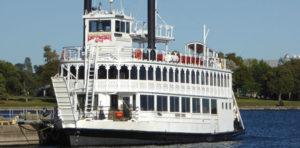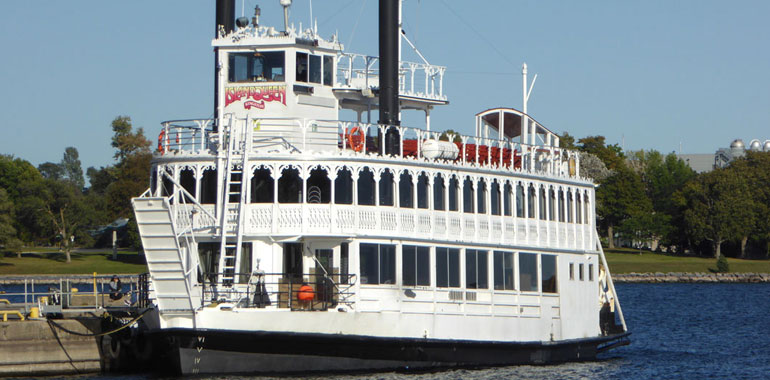Island Queen III was on a cruise in the Thousand Islands area of the St. Lawrence River when it made contact with the bottom, causing enough damage to flood the vessel’s steering compartment. No injuries were reported, but an investigation revealed safety deficiencies involving life jackets and evacuation procedures.

Not long after departing Kingston, Ontario at 1237 on Aug. 8, 2017, Island Queen III deviated from its planned route and its position was being monitored solely by visual navigation, according to a report by the Transportation Safety Board of Canada (TSB). The 90-foot vessel was sailing with 279 passengers, 10 crewmembers and an entertainer on board.
Weather was clear with 10- to 15-knot winds. The water level was about 2 feet higher than the average for August, and the river’s estimated speed was 0.1 knots.
At about 1240, the vessel approached Point Frederick Shoal, where some sailing school dinghies were training to port. After passing the shoal buoy, the master turned to a heading of 090 degrees true. A second fleet of dinghies was training off Point Henry, near Island Queen III’s planned route. To avoid them, the master continued past the planned turning point toward Cedar Island, where more dinghies were training. Once the vessel was clear of the boats at Point Henry, the master turned to port to a new course of approximately 010 degrees true, giving a wide berth to the third fleet.
The master was now navigating only visually, continuing up Deadman Bay toward Cartwright Point. At approximately 1244, he applied 5 degrees of starboard helm to return the vessel to its planned course. The master determined Island Queen III was northwest of its planned route, and he checked the electronic chart system to confirm sufficient water depth in the area.
At approximately 1245, the master visually determined that the vessel’s heading was too close to Cartwright Point. He applied 3 degrees of starboard helm until the bow was aligned with the center of Whiskey Cut. Still concerned about the vessel’s proximity to the point, the master applied 3 degrees more of starboard helm.
At 1246, Island Queen III struck a submerged rock southwest of Cartwright Point. The vessel’s keel made contact first, followed by the port propeller, which caused the engine on that side to stall. The port rudder also was jammed approximately 5 degrees to port.
At 1250, the mate entered the steering compartment and saw that water had flooded in to a depth of about 6 inches. There was a gash about a foot long in the aft port side of the hull. The vessel’s engineer started the compartment’s bilge pump and crewmembers also manually bailed water as the level rose.
Island Queen III returned to the dock at approximately 1315 and was secured. The hull was temporarily plugged from the outside and the vessel was put into dry dock the following morning.
TSB investigators noted three safety concerns after inspecting the excursion boat:
• Transport Canada requires that every vessel of more than 5 gross tons and certified to carry more than 12 passengers have one life jacket for every person on board. The vessel also must carry children’s life jackets for at least 10 percent of the maximum vessel complement or one for each child on board, whichever is greater.
TSB investigators determined that there were 32 children and four infants on board Island Queen III, but the vessel carried only 31 child life jackets. There was no procedure in place to count the number of children and infants.
• Canada requires that all passenger vessels have an evacuation procedure that outlines how all passengers and crewmembers will be evacuated from the vessel within 30 minutes of the abandon-ship signal being given. Investigators concluded that there was no evidence of Island Queen III having an evacuation procedure.
• Crewmembers on vessels making sheltered voyages receive minimal training in passenger management as part of their marine emergency duties (MED) training. The six-hour MED course that Island Queen III’s crew completed has only 15 minutes allotted to crowd control.
“(The TSB) is concerned that, until such time as the crewmembers of all vessels carrying more than 12 passengers are required to complete appropriate training in passenger safety management, there remains a risk that crewmembers will not be prepared to manage passengers effectively in emergency situations,” the report said.
On a navigation note, the TSB said visual monitoring of the vessel’s position should have been complemented by radar or use of a paper or electronic chart.
“The use of a single navigational system or method constitutes a single point of failure; using several methods to monitor the ship’s position is therefore fundamental to safe navigation,” the report said.
The TSB said its recommendations to the vessel’s owner, Kingston & The Islands Boat Lines Ltd., would focus on navigation planning and monitoring, situational awareness, passenger safety management, safety management systems and alerting search and rescue services after an incident occurs. •
Eric Colby

